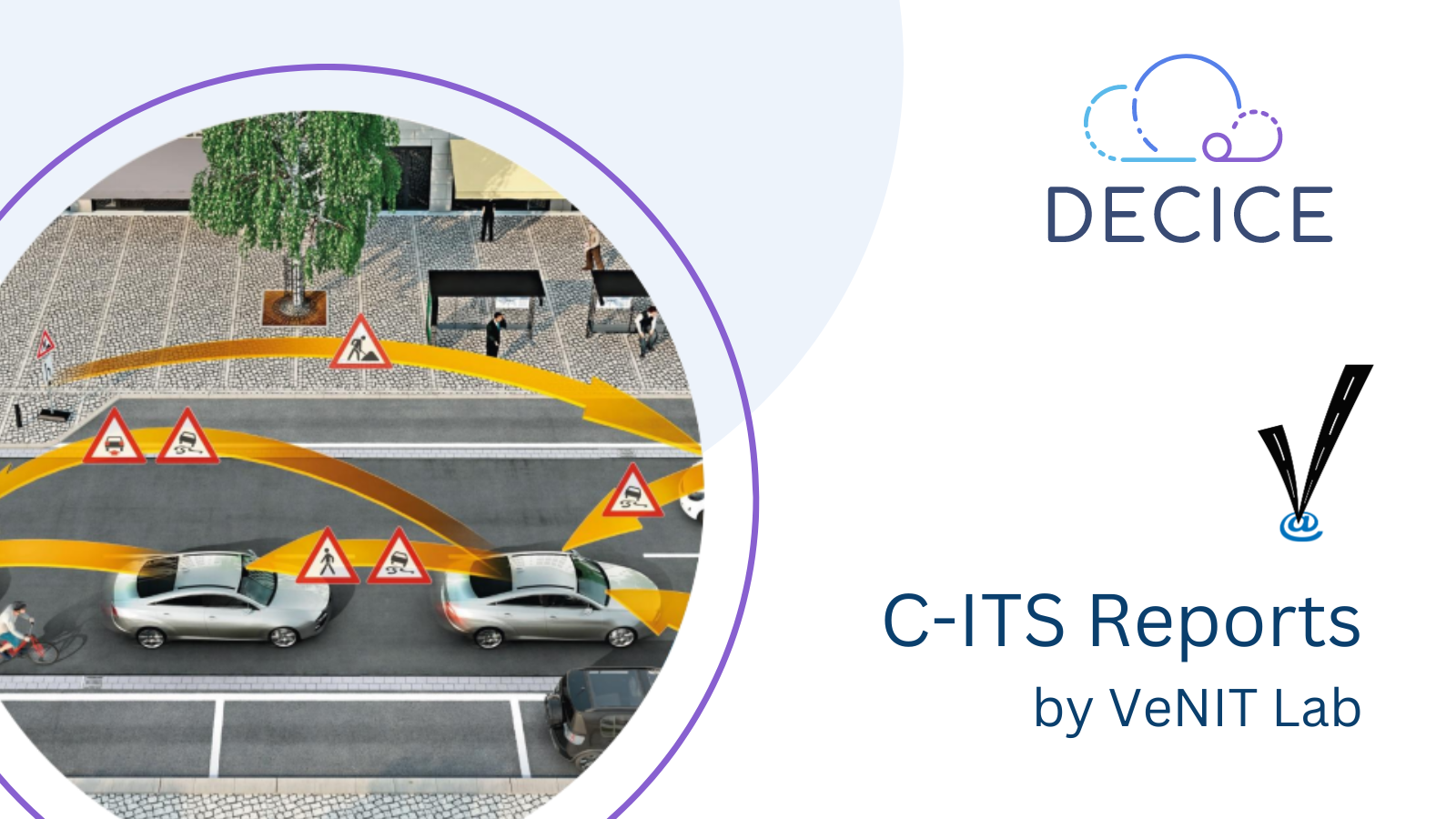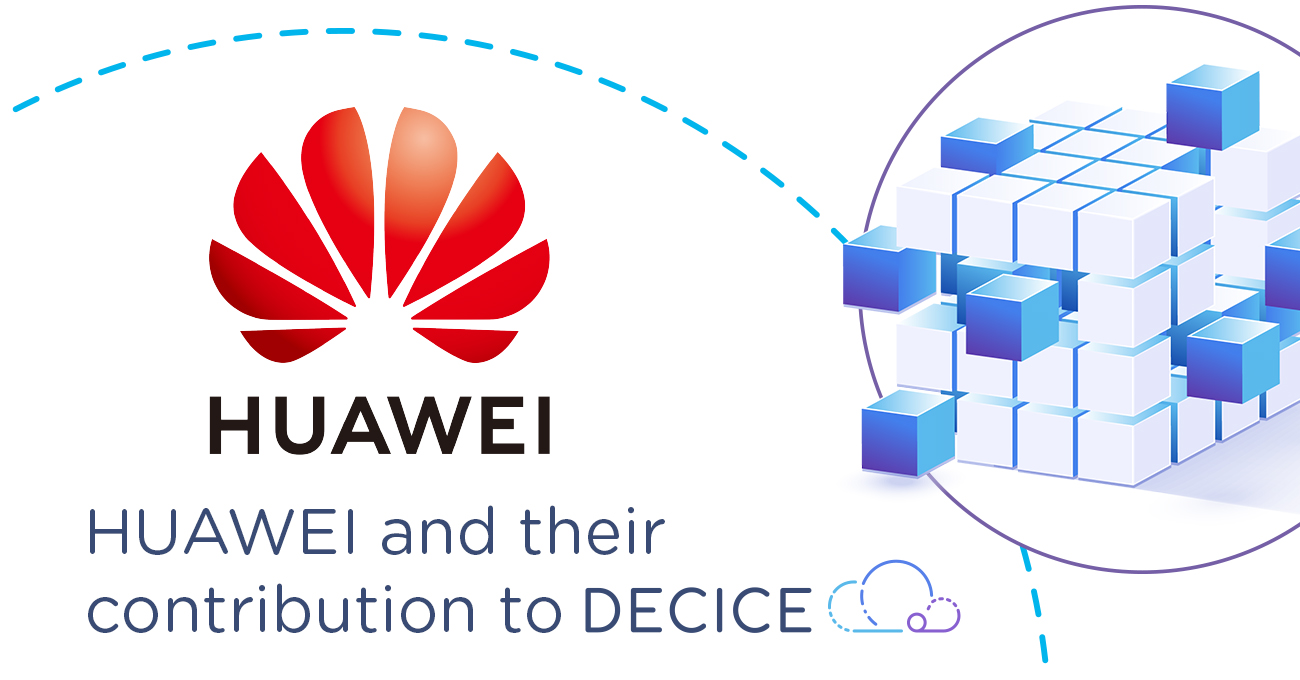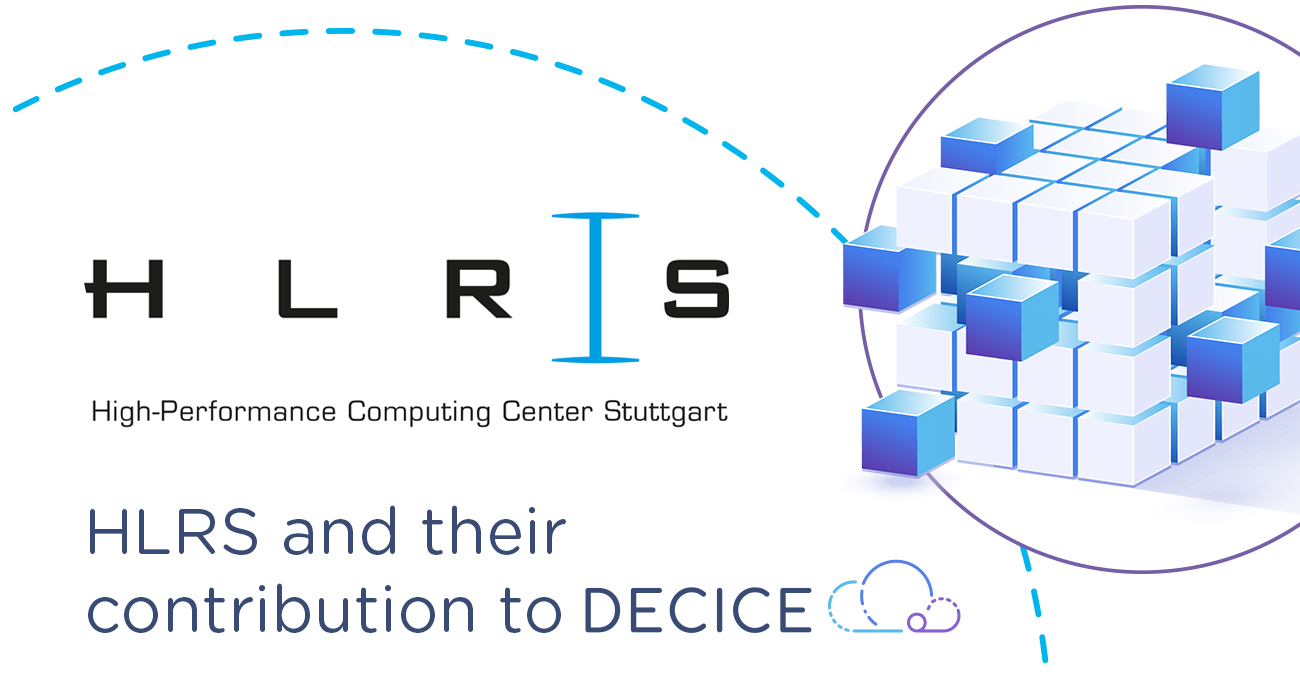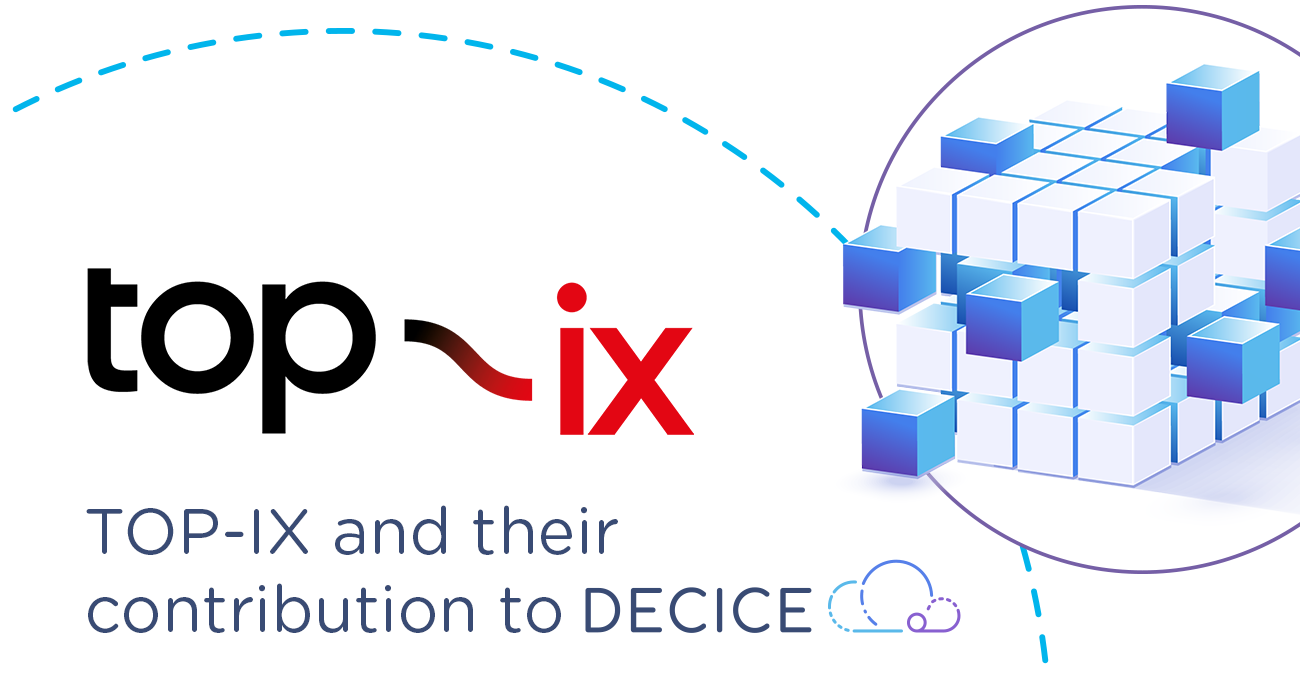
From IXP to federated service composition points – The TOP-IX vision to support the European Cloud Sovereignty
The TOP-IX vision to support the European Cloud Sovereignty. The pervasive and exponential diffusion of cloud-based services, the high market concentration and the lack of European leadership in this strategic sector make it necessary to design, develop and implement new governance, technical and business models aimed at restoring digital sovereignty, fostering innovation and making the market accessible to a large and diverse set of players, therefore allowing a dynamic and healthy competition. Within DECICE, TOP-IX is pursuing its vision to explore the future of the Internet Exchange model moving toward a Service Composition Point.

Photo by Lucas George Wendt on Pexels : https://www.pexels.com/it-it/foto/colori-raggiante-illuminato-lampadine-10604123/
PREFACE
Consorzio TOP-IX, widely known as TOP-IX (TOrino and Piemonte Internet eXchange), is a non-profit consortium located in Turin. It counts 90+ members including SMEs, large ICT and TLC corporations, public institutions and local universities.
The Consortium was created in 2002 with the aim to increase the development of the Internet infrastructure in the North-West of Italy by running an Internet Exchange Point (IXP). TOP-IX supports Peering and Network Neutrality as means to advance Internet development and is committed to work on interconnection evolution. Currently, there about 120 connected networks and additional interconnection services available as Marketplace and Point to Point connectivity. Moreover, through its Development Program, TOP-IX aims to leverage (its) network infrastructure as a key tool for strengthening competitiveness and fostering growth in the economic system at large.
KEY CHALLENGE: RESTORE EUROPEAN DIGITAL SOVEREIGNTY
On the one hand, the growing diffusion of the cloud is progressively changing the technology and business models for service demand and supply, making software-enabled flexibility, scalability and composition the biggest trend and driver in every application domain.
On the other hand, Europe is not the leader in the cloud market, dominated by a few private players, which implies the lack of digital sovereignty and the risk of a total technological and business lock-in, which limits competitiveness and ultimately growth and social equality.
Therefore it is necessary to design, develop and implement governance, technical and business models that are aimed at restoring digital sovereignty, fostering innovation and making the market accessible to a large and diverse set of players.
FROM INTERNET EXCHANGE POINTS (IXPS) TO SERVICE COMPOSITION POINTS
To this extent, TOP-IX, born as an IXPs and promoting innovation through its Development Program, sees a disruptive opportunity to evolve from its traditional IXP role towards a new model, called Service Composition Point, positioned as an entry point and neutral broker that enables and leverages the existence and growth of a large number of very diverse stakeholders.
An Internet exchange point (IXP), in fact, is a network facility through which Internet infrastructure companies such as Internet Service Providers (ISPs) and Content Delivery Networks (CDNs) or Cloud Providers connect with each other. These facilities exist in every EU country and allow providers to share transit outside their own network in a more efficient way by shortening their path to the transit coming from other participating networks, thereby reducing latency, improving round-trip time, and potentially reducing energy consumption and costs of interconnections.
The IXPs have neutrality and diversity in their DNA. Indeed they have been created in order to enable interconnection, guaranteeing the participation of players of any size in the value created by the Internet. Furthermore, being the connection point between diverse stakeholders, they implement a de facto distributed governance model, which aims at guaranteeing independence from possible dominant positions of single players.
Therefore, in a scenario that progressively evolves toward software-based and multistakeholder infrastructure, services and solutions, the next generation of IXPs, by extending their intermediary functionality towards computing, data and service layers, seems to be the optimal and disruptive candidate for the role of brokers of the cloud market.
This new kind of intermediary will be called Service Composition Point (SCP), enabling the discovery, selection, composition, consumption and payment of different services, ranging from interconnection to applications.
TOP-IX aims, possibly with its European counterparts, at the creation of a Federation of Service Composition Points, which represent the evolution of IXPs aimed at guaranteeing the maximum flexibility for customers willing to access and dynamically compose diverse services and offers. As already mentioned, a neutral point would be created through which services could be offered, discovered, composed, consumed and paid, thanks to standardised technologies, protocols and rules at European levels. This Federation would enable a multistakeholder network and computing fabric, which could be the necessary sovereign layer to support existing and emerging digital (e.g. data & AI-driven) services.
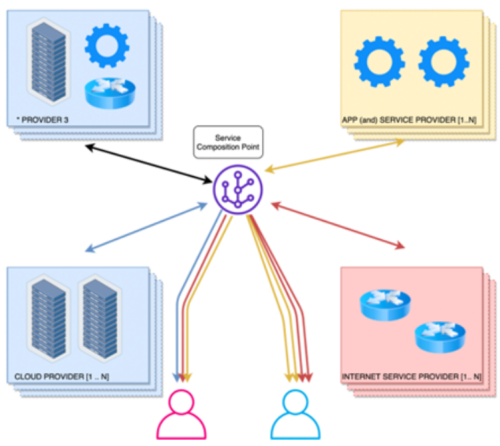
Reference architecture for a Service Composition Point
KEY ARCHITECTURAL DRIVERS
More in detail, TOP-IX has identified several drivers which will be key for the development and evolution of a vibrant cloud market, distributed and pervasive (till the edge of the network):
Data and infrastructure
Architectures
Network
Storage & Computing
Data Spaces
Data and infrastructure
The flood of data from people, companies, and devices is expected to grow rapidly, fueling the development of AI-based products and systems. Europe aims to lead in this data-driven economy by creating a single market with transparent and secure data circulation, benefiting businesses, governments, and individuals. Currently, non-European players dominate the data market, posing a threat to Europe’s digital sovereignty. Therefore, Europe is promoting initiatives to establish rules and frameworks to prevent technological dependence and foster transparent data circulation while ensuring adequate computing performance. This vision requires the development of suitable infrastructures, including network, computing and storage resources and architectures.
Architectures
The rise of devices and data calls for a new strategy to balance the centralization and distribution of computing and transmission infrastructure efficiently. While most computing processes are centralized currently, the trend is expected to shift toward computing resources at the edge due to security, privacy, and efficiency needs. This trend requires federated approaches to control costs and avoid network congestion while guaranteeing data security and privacy. Dynamic resource federations are necessary to ensure a seamless computing continuum, portability and interoperability of data and services within secure and trusted digital ecosystems. The availability of real-time and on-demand data also requires architectural continuity between low and high computational performance.
Network
A high-capacity, secure, and robust network is essential for a data economy and AI development. Interconnection strategies should enable traffic exchange between stakeholders at sustainable economic conditions. A wide service offer for connectivity, computing, storage, and applications is necessary without geographic or provider limits. Neutral interconnection points are key for offering plurality and connectivity robustness. Networks require dynamic adaptation capability for the computing continuum, which relies on re-routing traffic to the edge. Distributed brokering and interconnection services enable a multiplicity of offers at the edge and implementation of high-performance services like autonomous driving and remote sensing. At the same time, a Federation between neutral interconnection points (e.g. IXPs) would create a robust, multi-stakeholder, capillary and naturally distributed network fabric with tunable interconnection performance and paths.
Storage & Computing
The network’s densification, device multiplication, and AI growth require increased computing capacity and architectures that provide smooth computation from the centre to the edge. This requires ensuring the portability, scalability, and interoperability of data, apps, and services via various computing and storage resources. A distributed computing architecture is needed for pervasive, less centralized access to high computing performance. This will open new markets and foster the growth of a data economy. Various solutions for data centres, with different granularity in terms of centrality, security, performance, access rules, and cost, need to be experimented with and made available.
Data Spaces
Discussion and experimentation about possible data storage, enrichment and processing solutions are crucial in this context. Also in this case, it is necessary an optimal trade-off between solutions ranging from data warehouses and data lakes to totally distributed and federated architectures. Different demands as regards security, service criticality, and confidentiality will be satisfied by different solutions, but an efficient and robust infrastructure must be designed, realised and optimised in order to be able to meet all these different needs.
Leveraging an infrastructure initially aimed at experimentation and progressively turned into an operational one, it would be necessary to test different solutions as regards “Data Spaces”, including also different policy and governance models (e.g. Data Collaboratives and Data Mesh).
CONCLUSIONS
TOP-IX, a non-profit consortium located in Turin, aims to restore European digital sovereignty by developing governance, technical, and business models. TOP-IX aims to evolve from its traditional IXP role to a new model called Service Composition Point (SCP) to act as an entry point and neutral broker that enables and leverages the existence and growth of a large number of diverse stakeholders and providers. The SCP will enable the discovery, selection, composition, consumption, and payment of different services ranging from interconnection to applications. TOP-IX also aims to create a Federation of Service Composition Points in order to enable a distributed multistakeholder network and computing fabric and to offer, discover, compose, consume and pay services through technologies, protocols, and rules “standardized” at the European level. The development of a vibrant cloud market distributed and pervasive till the edge of the network requires key architectural drivers such as data and infrastructure, architectures, network, storage and computing, and data spaces.
Authors: Leonardo Camiciotti, Christian Racca, Gabriele Rocca, Luca Rocco
Links
Keywords
#digitalsovereignty #computercontinuum #broker #ixp #servicecompositionpoint #federation #edgecomputing #infrastructure
